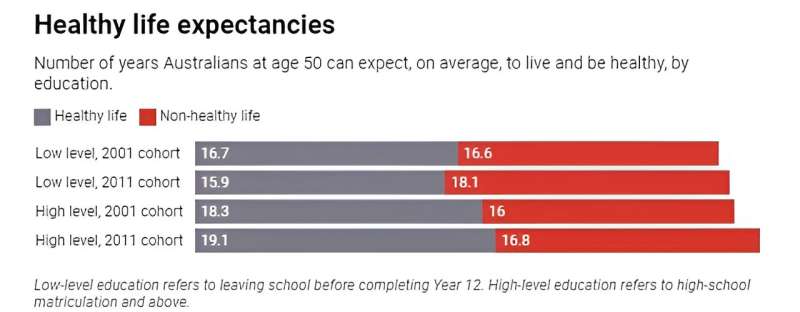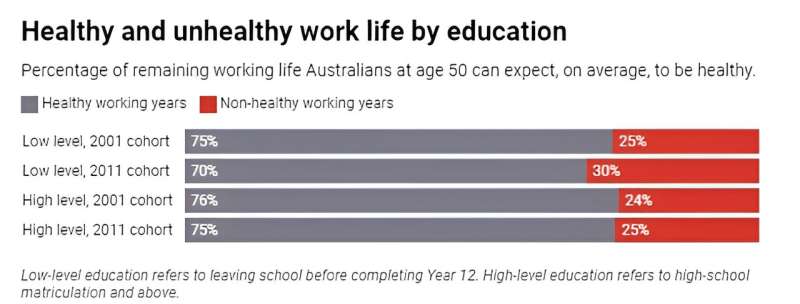This article has been reviewed according to Science X's editorial process and policies. Editors have highlighted the following attributes while ensuring the content's credibility:
fact-checked
trusted source
written by researcher(s)
proofread
Australians are living and working longer—but not necessarily healthier, new study shows

Australians are living and working longer, but a longer working life doesn't always come with equivalent gains in healthy life.
Our analysis
of change in life expectancy,
In particular, education matters.
Those who left school before year 12 are losing years of healthy life, with their extra years in the workforce mainly comprising years of poor health. This is opposite to the trend among people who completed high school.
And while men and women experienced improvements in life expectancy, on average women are not gaining extra healthy life years.
Australians are being encouraged to extend their working life. For this to be sustainable and equitable, government and workplaces policies will need to make allowances for the health capacity of mature-age workers.
How we found our results
We've calculated healthy working life expectancies—the average number of years a person can expect to work in good health—for 50-year-olds using data from the Household, Income and Labour Dynamics in Australia (HILDA) survey. This is a longitudinal survey, meaning it seeks to interview the same households every year (about 17,000 people), enabling researchers to track life trajectories.
We identified two age groups within HILDA's survey sample and followed each cohort for 10 years. The first group was 4,951 people aged 50 years and older in 2001. The second group was 6,589 people aged 50 years and older in 2011.
To estimate a healthy working life expectancy, we looked at how people transitioned in and out of good health and employment each year (based on survey data about their paid employment and long-term health conditions that limited participation in everyday activities).
By combining this with deaths data, we have calculated the average duration spent (i) working in good health, (ii) working in poor health, (iii) retired in good health, and (iv) retired in poor health.
Differences by education
The following graphs show our results, based on expectancies at age 50.
We show our data in this way, rather than total healthy life and working life expectancies from birth, because we followed people from age 50 and is this is the time from which workers start to plan for and transition into retirement.
Typically we understand life expectancies to be calculated from birth, but they can be estimated for any age. If you live to 50, your life expectancy is greater than when you were born.
Our first graph shows healthy life expectancies according to school completion. These estimates reflect the cumulative number of years a person will, on average, be healthy or unhealthy from age 50.
Across the two cohorts, those with low education lose 0.8 years of healthy life, while those with high education gain 0.8 years of healthy life.
As with all statistics, there is uncertainty in these estimates. (Our original analysis includes 95% confidence intervals but we do not show them here.)

These inequities are amplified in working-life expectancies, as the next graph shows. Among early school leavers, at age 50 healthy work years rose from 7.9 to 8.4 years, an increase of six months. But their years working in poor health rose from 2.7 to 3.6 years, a difference of 11 months.
In contrast, for those who completed year 12, at age 50 healthy work years rose from 9.6 to 10.5 years, an increase of 11 months. Their years working in poor health rose from 3.1 to 3.5 years, a difference of five months.

The next graph illustrates what this means in proportional terms.

The next graph shows working life expectancies by sex. Men, on average, will spend 25% of their remaining working years in poor health, and women 24%. These percentages have not changed over time.

These findings are consistent with previous analyses demonstrating social inequalities in health expectancies to have been maintained over time, and possibly widened in some circumstances. In that study, women with low educational attainment appeared to have had negligible improvements in life expectancy and lost healthy life years.
Implications for governments and employers
Australia has this month raised the age at which people qualify for the age pension to 67.
When the pension was introduced in 1908, the qualifying age was 65 for men and 60 for women. At the time, average life expectancy for Australians at birth was about 55 for men and 59 for women. Now it exceeds 81 for men and 85 for women (though is considerably lower for some groups, notably Indigenous Australians).
There's an obvious rationale to prolong people's working lives—to meet the challenges posed by population aging and sustain the social security system. Nevertheless, consideration should be made for inequalities in life expectancy and health expectancy. For many aging workers, health limitations constrain their capacity and opportunity to work.
To achieve longer working lives, workplaces will be need become more supportive of mature-age workers, including accommodating long-term health conditions.
This will likely involve addressing ageism in the workplace, increasing employer demand for older workers, creating appropriate work roles to fit the capacities and preferences of older workers, and providing pathways to lifelong education and training.
We may also need to rethink our idea of flexible work, which has largely centered around the needs of parents and younger workers. Many older workers will have expectations for an independent and active retirement period, and it should be possible for flexible work arrangements to accommodate this.
Finally, we should not discount the unpaid contributions made by many older adults through community service and providing care to loved ones.
More information: Mitiku Teshome Hambisa et al, Gender, education, and cohort differences in healthy working life expectancy at age 50 years in Australia: a longitudinal analysis, The Lancet Public Health (2023). DOI: 10.1016/S2468-2667(23)00129-9 , www.thelancet.com/journals/lan … (23)00129-9/fulltext
This article is republished from The Conversation under a Creative Commons license. Read the original article.![]()


















